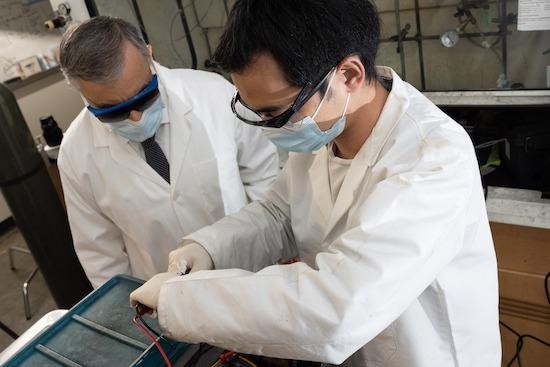The ever-increasing demand for rare-earth elements (REE), including metals, continues to accelerate due to their role as critical components in today’s high-tech society. These elements are central components of our mobile phones, computers and many other devices we use on a daily basis.
 Image Credit: Jeff Fitlow/Rice University
Image Credit: Jeff Fitlow/Rice University
However, limited availability and the environmentally destructive processes of mining rare-earth metals means we must find new, innovative ways to efficiently recover these metals. Now, a group of researchers at Rice University, Houston, Texas, have devised an exciting method that has the very real potential to recover valuable REE from waste.
James Tour, professor of Materials Science and Nanoengineering, and his lab have reported how its flash Joule heating process – originally developed to generate graphene allotropes from solid carbon – has been tested on three sources of REE.
Published in the journal Science Advances, Tour and his team explain how they were able to recover rare-earth metals from three different sources: electronic waste, coal fly ash and bauxite residue.
Upon recovery, the metals still demonstrated electronic and magnetic properties key to the functionality of today’s modern electronic devices and potentially useful for green energy solutions.
While some rare-earth elements tend to not be rare in abundance – gold is much rarer than all REE – they are distributed over vast areas and notoriously complicated to extract with major downsides, such as heavy pollution, environmental impact and high costs.
“The U.S. used to mine rare earth elements, but you get a lot of radioactive elements as well,” Tour explained.
You’re not allowed to reinject the water, and it has to be disposed of, which is expensive and problematic. On the day the U.S. did away with all rare earth mining, the foreign sources raised their price tenfold.
James Tour, professor of Materials Science and Nanoengineering, Rice University
With the negative environmental impact, researchers are turning towards the development of recycling techniques to extract rare-earth metals and other elements from industrial waste and byproducts, including coal fly ash (CFA).
The residue of burning coal is silicon, aluminum, iron and calcium oxides that form glass around the trace elements, making them very hard to extract.
James Tour, professor of Materials Science and Nanoengineering, Rice University
Other sources include electronic waste (E-waste) and bauxite residue (red mud), which is a toxic industrial waste generated during aluminum production. If these waste products are not treated or disposed of properly, they can pose a threat to the environment, causing pollution and even leading to health problems amongst a local population.
Conventional extraction methods from waste to recover rare-earth metals usually necessitate labor-intensive leaching processes using non-environmentally friendly strong acids. However, the Rice Lab’s flash Joule heating process is able to heat waste products – including coal fly ash – to temperatures around 3,000 degrees Celsius in about a second.
Tour says the process “breaks the glass that encases these elements and converts REE phosphates to metal oxides that dissolve much more easily.”
The process also incorporates the use of carbon black material to boost conductivity while using much milder acid concentrations than conventional industrial means of extracting REE from waste.
Furthermore, the Rice Lab’s low-acid process was able to produce much greater yields of rare-earth elements, more than twice the amount of traditional leching practices using strong acids.
The team also established that the process could be generalized for use on a wide range of waste and byproducts.
We proved that the REE recovery yields were improved from coal fly ash, bauxite residue and electronic wastes by the same activation process.
Bing Deng, Postdoctoral Researcher and Co-Author
With large amounts of industrial waste generated annually, the Rice Lab’s flash Joule heating process could offer a radical, environmentally friendly alternative to conventional REE extraction and recovery methods. This could see the phasing out of destructive mining practices and be one of the many tools needed in our armory to combat the climate crisis.
References and Further Reading
Williams, M., (2022) Rare earth elements await in waste. [online] Rice News | News and Media Relations | Rice University. Available at: https://news.rice.edu/news/2022/rare-earth-elements-await-waste
Disclaimer: The views expressed here are those of the author expressed in their private capacity and do not necessarily represent the views of AZoM.com Limited T/A AZoNetwork the owner and operator of this website. This disclaimer forms part of the Terms and conditions of use of this website.